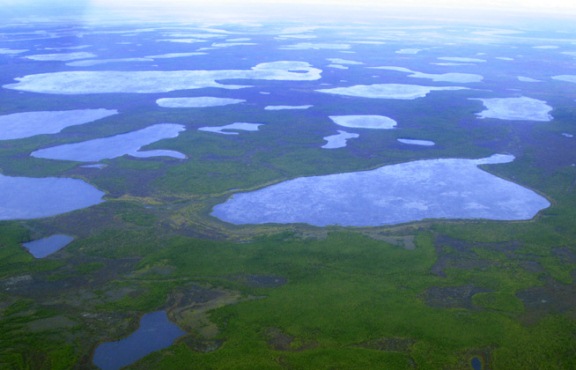The Runaway Greenhouse Effect
It’s sitting just under the permafrost

The melting permafrost. This whole region was all white until recently. Now, with no ice cover, the peat moss is releasing methane gas into the atmosphere.
It’s beginning to melt. It will turn a white desert of heat-reflecting frost into a black swamp of heat-absorbing bog. And it would send climate change into overdrive.
Beneath the frozen depths of the Arctic, the icy soil stores an estimated 1.5 trillion tons of carbon – including methane and other hydrocarbons — twice as much as is found in the atmosphere. These greenhouse gases are locked up in frozen ground that covers 24 percent of the exposed land in the high latitudes of the Northern Hemisphere, as well as Antarctica and the Patagonia region of Argentina and Chile.
As this permafrost begins to melt – which is happening — greenhouse gases are now escaping and entering the atmosphere at a rate of up to 50 billion tons of methane per year.
Methane is not your everyday CO2 gas. It heats the atmosphere with 25 times the efficiency of carbon dioxide.
The release of this stored carbon could change climate in the Arctic in ways researchers have yet to fully understand. Researchers, such as Larry Hinzman of the University of Alaska, Fairbanks, are digging deeper to find out more.
“In Alaska,” says Larry Hinzman of the University of Alaska, “we’re living right on the knife’s edge between frozen and thawed landscape. Temperature changes here affect the structural stability of entire ecosystems much more than in other states.”
Dr. Hinzman is the director of the International Arctic Research Center at the University, and a leading expert on permafrost.
“If permafrost degrades even a foot, it will act like a big domino that knocks everything else over. Thawing permafrost releases methane into the atmosphere in amounts potentially far greater than human emissions. Permafrost below the Arctic Ocean has trapped huge quantities of methane (called gas hydrates), and as the permafrost degrades, the amount of escaping methane increases, with implications for climate change.
Dr. Hinzman says that thawing permafrost plays a role in controlling infiltration of rain and snowmelt, which affects the timing of eventual runoff into rivers and to the ocean. “We know for sure that the increased runoff is contributing to a freshening of the waters of the Arctic Ocean. Lower-density freshwater tends to float on the saltier ocean water. Increases in fresh water near the Earth’s poles could affect the circulation in the oceans, which influences everything from atmospheric temperatures to storm intensity.”
